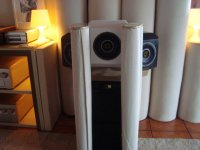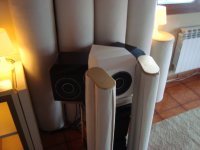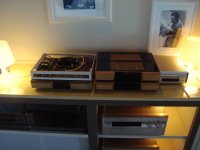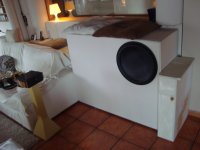Are these recorded binaurally?
Here is a binaural recording if my set up 4 years ago.
https://m.youtube.com/watch?v=7cVOI4-bj6g
The speaker is called the "event horizon"
There is a build thread here.
Btw, sweet soundlabs!
Thanx! Before this I was using Harbeth. Ambiophonics definitely sounds better with SL.
For some videos I used ZoomH1 and for others, I used the binaural CS-10Em. Between those two I don't hear much difference.
BTW, I am not sure about your recording. Am I hearing the sound from your speakers recorded with a binaural microphone?
Yeah, it's 1 speaker that has 2 channels
Using mini ambio.
Recorded with a dummy head.
The room was pretty empty, so it's a bit echoey.
And it was recorded on a Kodak play touch.
Not a good recording device
It is just a demonstration for imaging.....not audiophile sound.
Check out the build thread. Really nutty speaker.
http://www.diyaudio.com/forums/multi-way/217096-event-horizon-ambiopole.html
Using mini ambio.
Recorded with a dummy head.
The room was pretty empty, so it's a bit echoey.
And it was recorded on a Kodak play touch.
Not a good recording device
It is just a demonstration for imaging.....not audiophile sound.
Check out the build thread. Really nutty speaker.
http://www.diyaudio.com/forums/multi-way/217096-event-horizon-ambiopole.html
Last edited:
Alot of that effect is because it's pretty much an empty room.
Also, it's a binaural recording.
The play touch is just a video recorder. I got that because it had a stereo input as opposed to mono.
I wanted to be able to record video with binaural sound at the same time, instead of separately.
But the video on the play touch was so bad I didn't even use it. Lol.
Also, it's a binaural recording.
The play touch is just a video recorder. I got that because it had a stereo input as opposed to mono.
I wanted to be able to record video with binaural sound at the same time, instead of separately.
But the video on the play touch was so bad I didn't even use it. Lol.
Thanx! Before this I was using Harbeth. Ambiophonics definitely sounds better with SL.
For some videos I used ZoomH1 and for others, I used the binaural CS-10Em. Between those two I don't hear much difference.
BTW, I am not sure about your recording. Am I hearing the sound from your speakers recorded with a binaural microphone?
That's crazy how they would sound similar....
The zooms microphones are 1 inch apart with no obstical between for HRTF.
That's crazy how they would sound similar....
The zooms microphones are 1 inch apart with no obstical between for HRTF.
The ZoomH1 is a X/Y configuration microphone. I will make another video with CS-10EM and Zoom for side by side comparison. I believe the difference wasn't obvious because I limit the soundstage of my main speakers Ambiophonics setting to about 120 degrees. Do you want to suggest any tracks with wide soundstage?
This whole album.
http://youtu.be/-AAkq2Vm5wQ?list=PLqyvvqB5g-kNGwP-vFa6oXn8EbWV1594h
http://youtu.be/-AAkq2Vm5wQ?list=PLqyvvqB5g-kNGwP-vFa6oXn8EbWV1594h
Unable to view your video in my country.
edit: Thanks. The video is playable using proxy.
David asked me about my current system and I could not attach the photos in the pm, so here they go:
many years ago such experiments with a physical barrier and an extreme toe-out of L and R loudspeakers had eventually led me to Stereolith-like solutions with no barrier
http://www.diyaudio.com/forums/multi-way/10962-stereolith-loudspeakers-question.html
what You have there is in fact a kind of stereo from a single loudspeaker
An externally hosted image should be here but it was not working when we last tested it.
http://www.diyaudio.com/forums/multi-way/200040-stereophonic-sound-single-loudspeaker.html
http://www.diyaudio.com/forums/multi-way/222698-ep21-single-stereo-loudspeakers.html
I've tried that tool as others and I've lived with ambiophonics for 7 years already with a wide variety of speakers and rooms and barriers.
Trust me when I tell you, if you want Ambiophonics, use a thick physical barrier with an absorptive surface. The digital crosstalk cancellators are terrible and they don't even work properly, they are a joke. You could use them on cheap speakers and at close range <1m if you really want to...
If you want good sound, the physical barrier is the way to go. If you're not willing to divide your room with a massive physical barrier for the sake of sound: FORGET IT!!
Random observations:
1) I agree, the physical barrier thing works pretty darn well
2) I've notice that the various implementations of Ambio sound quite different. I have a miniAmbio and I've tried two or three different implementations on the PC
3) As alluded to by Melo, I *did* get quite good results doing this:
a) Set up an additional set of satellites near your listening chair
b) feed those satellites with the same signal as your main speakers, but delayed and inverted.
b) feed those satellites with the same signal as your main speakers, but delayed and inverted.
The way that this works is very similar to ambio. The difference is that the crosstalk cancellation isn't done at the loudspeaker, or in a processor. The crosstalk cancellation is done at your seat. This has a few advantages. First, it doesn't have that weird 'lispy' quality that some of the ambio processors suffer from. Second, it doesn't kill the dynamics as much as some ambio processors to. This is because the amplitude of the cancellation signal isn't as large as it would be if the cancellation was being done with a processor, or done at the loudspeaker itself a la Polk.
All of this can be implemented with a plain ol' minidsp.
I went this route for a few weeks, but abandoned it because the stage was TOO big. I listen to a lot of EDM, that's already heavily processed, and the addition of my crosstalk cancelllation satellites created a huge stage that sounded neat, but was kinda fatiguing.
Random observations:
1) I agree, the physical barrier thing works pretty darn well
2) I've notice that the various implementations of Ambio sound quite different. I have a miniAmbio and I've tried two or three different implementations on the PC
.......,.
................
.
IMO, using physical barrier requires complete isolation and it was difficult to do so in our normal room. I tried them in the early 2000s but wasn't practical and difficult.
I have tried both the MiniDSP Ambio plugin and AmbiophonicsDSP. I prefer the DSP with JRiver.
In my system, with Harbeth SHL5 and M-3PX Sound Lab speakers, the DSP version triumphs over stereo setup.
Having said that, for some recordings with a lot of pseudo stereo, you may perceive unnatural soundstage which can be controlled with the space and zentrum function.
Please try Ambiophonics with Linn, Telarc or western classical music to understand the proper settings. Once, you understand the way to control the soundstage and tonal characteristics then it is easier to move to other types. of recordings.
Sent from my iPhone using Tapatalk
[QUOTEgraaf: are you still using this SSS? How is (or was) the wiring in the box done and how the whole setup from source to SSS looks like?
...same question to Poldus
Today 12:37 AM][/QUOTE]
The center speaker is only used for movies as a dialogue center channel. The side speakers go through a miniambio with recursion level on the soft side.
The point source speakers and the extended lows from the subwoofer help to the overall effect.
...same question to Poldus
Today 12:37 AM][/QUOTE]
The center speaker is only used for movies as a dialogue center channel. The side speakers go through a miniambio with recursion level on the soft side.
The point source speakers and the extended lows from the subwoofer help to the overall effect.
graaf: are you still using this SSS? How is (or was) the wiring in the box done and how the whole setup from source to SSS looks like?
...same question to Poldus
IIRC the SSS wiring is explained in Elias Pekonen's threads and on his website: http://elias.altervista.org/html/SingleSpeakerStereo.html
for my part I had used only pure bipolar L-R, no center channel, eventually toed-out 90 degrees to the sides and no barrier, and no ambio algorithms - those were mainly pre-computer audio days, at least for me
I don' use it anymore - it was physically incompatible with a TV setup for watching movies - one needs two speakers symmetrically to the TV set, not one in front of it
I've been using a FCUFS/flooder setup for many years now.
IIRC the SSS wiring is explained in Elias Pekonen's threads
I mean those linked above
if I got it right, that looks somewhat like an "XY" stereo microphone setup reversed...for my part I had used only pure bipolar L-R, no center channel, eventually toed-out 90 degrees to the sides

well, not really: such a setup could be easily and conveniently placed behind the TV, rather than in front of it!I don' use it anymore - it was physically incompatible with a TV setup for watching movies - one needs two speakers symmetrically to the TV set, not one in front of it
Actually, adding some acoustic absorbent on the back of the TV screen will turn it into an acoustic barrier which should stop direct sound from the speakers, allowing first reflection from side walls to come first to the ear. That may be a very interesting arrangement, which perhaps may give some quite interesting results...
if I got it right, that looks somewhat like an "XY" stereo microphone setup reversed...
perhaps I should say 180 degrees
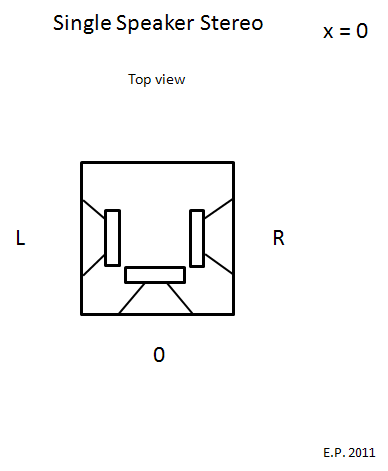
well, not really: such a setup could be easily and conveniently placed behind the TV, rather than in front of it!
Actually, adding some acoustic absorbent on the back of the TV screen will turn it into an acoustic barrier which should stop direct sound from the speakers, allowing first reflection from side walls to come first to the ear. That may be a very interesting arrangement, which perhaps may give some quite interesting results...
difficult when You have the TV set mounted on the wall
Latency?
Sorry to bump an old thread but it seems relevant to the topic...
Do ambiophonic filters have latency? If so, what is the approximate delay of the various flavor of ambiophonic filters/players (milliseconds/seconds)? I'm curious so I can determine hardware/software requirements to delay video when using with a live video stream to keep audio in sync.
Sorry to bump an old thread but it seems relevant to the topic...
Do ambiophonic filters have latency? If so, what is the approximate delay of the various flavor of ambiophonic filters/players (milliseconds/seconds)? I'm curious so I can determine hardware/software requirements to delay video when using with a live video stream to keep audio in sync.
- Home
- Loudspeakers
- Multi-Way
- Try Ambiophonics with your speakers
